Top Rankings
Portland SD 1j School District ranks among the top 20% of public school district in Oregon for:
Category
Attribute
Overall Rank
Highest overall rank (Top 10%)
Math Proficiency
Highest math proficiency (Top 20%)
Reading/Language Arts Proficiency
Highest reading/language arts proficiency (Top 20%)
Science Proficiency
Highest science proficiency (Top 20%)
Diversity
Most diverse schools (Top 1%)
Community Size
Largest student body (number of students) (Top 1%)
For the 2025 school year, there are 9 public preschools serving 3,401 students in Portland SD 1j School District. This district's average pre testing ranking is 7/10, which is in the top 50% of public pre schools in Oregon.
ÎÛÎÛÂþ» Preschools in Portland SD 1j School District have an average math proficiency score of 38% (versus the Oregon public pre school average of 33%), and reading proficiency score of 47% (versus the 42% statewide average).
Minority enrollment is 61% of the student body (majority Black and Hispanic), which is more than the Oregon public preschool average of 52% (majority Hispanic).
Overview
This School District
This State (OR)
# Schools
86 Schools
91 Schools
# Students
42,518 Students
29,714 Students
# Teachers
2,527 Teachers
1,885 Teachers
Student : Teacher Ratio
17:1
17:1
District Rank
Portland SD 1j School District, which is ranked within the top 10% of all 186 school districts in Oregon (based off of combined math and reading proficiency testing data) for the 2021-2022 school year.
The school district's graduation rate of 86% has increased from 78% over five school years.
Overall District Rank
#16 out of 189 school districts
(Top 10%)
(Top 10%)
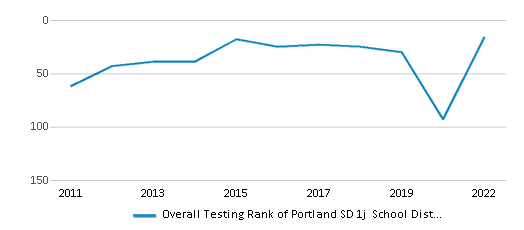
Math Test Scores (% Proficient)
44%
31%
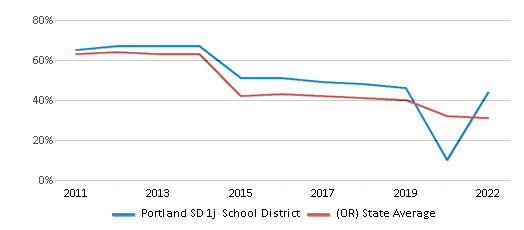
Reading/Language Arts Test Scores (% Proficient)
55%
44%

Science Test Scores (% Proficient)
39%
30%
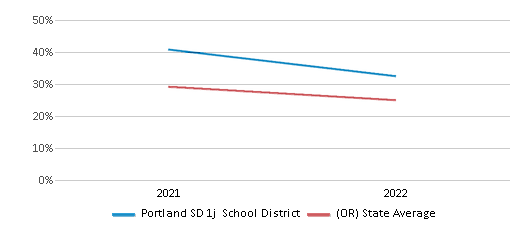
Graduation Rate
86%
81%
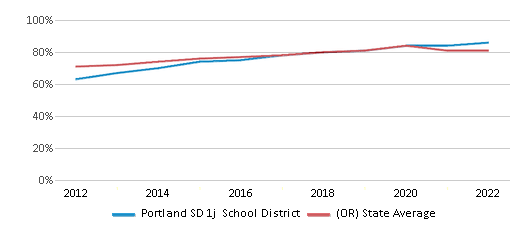
Students by Ethnicity:
Diversity Score
0.66
0.67
# American Indian Students
181 Students
200 Students
% American Indian Students
1%
1%
# Asian Students
2,433 Students
1,549 Students
% Asian Students
6%
5%
# Hispanic Students
7,344 Students
8,817 Students
% Hispanic Students
18%
30%
# Black Students
3,403 Students
1,664 Students
% Black Students
8%
6%
# White Students
23,048 Students
14,394 Students
% White Students
54%
48%
# Hawaiian Students
325 Students
371 Students
% Hawaiian Students
1%
1%
# Two or more races Students
5,156 Students
2,665 Students
% of Two or more races Students
12%
9%
Students by Grade:
# Students in PK Grade:
-
-
# Students in K Grade:
2,988
4,906
# Students in 1st Grade:
3,205
4,696
# Students in 2nd Grade:
3,317
4,983
# Students in 3rd Grade:
3,262
4,490
# Students in 4th Grade:
3,393
4,747
# Students in 5th Grade:
3,395
4,341
# Students in 6th Grade:
3,126
599
# Students in 7th Grade:
3,241
330
# Students in 8th Grade:
3,192
296
# Students in 9th Grade:
3,371
77
# Students in 10th Grade:
3,466
82
# Students in 11th Grade:
3,353
91
# Students in 12th Grade:
3,209
76
# Ungraded Students:
-
-
District Revenue and Spending
The revenue/student of $22,031 is higher than the state median of $18,279. The school district revenue/student has grown by 6% over four school years.
The school district's spending/student of $27,099 is higher than the state median of $19,325. The school district spending/student has grown by 6% over four school years.
Total Revenue
$937 MM
$9,902 MM
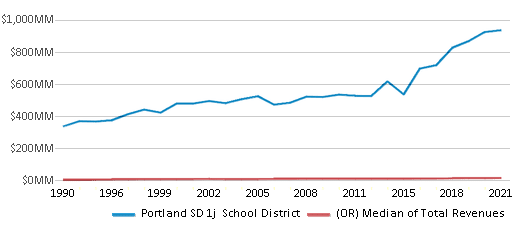
Spending
$1,152 MM
$10,468 MM

Revenue / Student
$22,031
$18,279
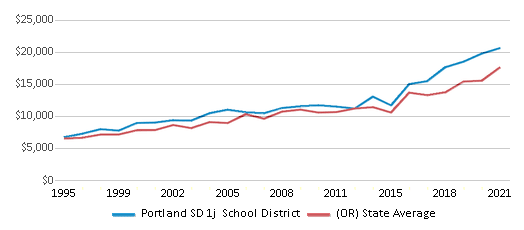
Spending / Student
$27,099
$19,325

Best Portland SD 1j School District ÎÛÎÛÂþ» Preschools (2025)
School
(Math and Reading Proficiency)
(Math and Reading Proficiency)
Location
Grades
Students
Rank: #11.
Sabin Elementary School
(Math: 65-69% | Reading: 70-74%)
Rank:
Rank:
10/
Top 5%10
4013 Ne 18th Ave
Portland, OR 97212
(503) 916-6181
Portland, OR 97212
(503) 916-6181
Grades: PK-5
| 302 students
Rank: #22.
Richmond Elementary School
(Math: 55% | Reading: 74%)
Rank:
Rank:
10/
Top 10%10
2276 Se 41st Ave
Portland, OR 97214
(503) 916-6220
Portland, OR 97214
(503) 916-6220
Grades: PK-5
| 537 students
Rank: #33.
Beach Elementary School
(Math: 60-64% | Reading: 60-64%)
Rank:
Rank:
10/
Top 10%10
1710 N Humboldt St
Portland, OR 97217
(503) 916-6236
Portland, OR 97217
(503) 916-6236
Grades: PK-5
| 325 students
Rank: #44.
Vernon Elementary School
(Math: 47% | Reading: 55%)
Rank:
Rank:
9/
Top 20%10
2044 Ne Killingsworth St
Portland, OR 97211
(503) 916-6415
Portland, OR 97211
(503) 916-6415
Grades: PK-8
| 579 students
Rank: #5 - 65. - 6.
Dr. Martin Luther King Jr. School
(Math: 35-39% | Reading: 40-44%)
Rank:
Rank:
6/
Top 50%10
4906 Ne 6th Ave
Portland, OR 97211
(503) 916-6456
Portland, OR 97211
(503) 916-6456
Grades: PK-5
| 305 students
Rank: #5 - 65. - 6.
Woodlawn Elementary School
(Math: 35-39% | Reading: 40-44%)
Rank:
Rank:
6/
Top 50%10
7200 Ne 11th Ave
Portland, OR 97211
(503) 916-6282
Portland, OR 97211
(503) 916-6282
Grades: PK-5
| 299 students
Rank: #77.
Boise-eliot Elementary School
(Math: 15-19% | Reading: 25-29%)
Rank:
Rank:
2/
Bottom 50%10
620 N Fremont
Portland, OR 97227
(503) 916-6171
Portland, OR 97227
(503) 916-6171
Grades: PK-5
| 307 students
Rank: #88.
Faubion Elementary School
(Math: 14% | Reading: 26%)
Rank:
Rank:
1/
Bottom 50%10
2930 Ne Dekum St
Portland, OR 97211
(503) 916-5686
Portland, OR 97211
(503) 916-5686
Grades: PK-8
| 570 students
Rank: #99.
Rosa Parks Elementary School
(Math: 6-9% | Reading: 10-14%)
Rank:
Rank:
1/
Bottom 50%10
8960 N Woolsey Ave
Portland, OR 97203
(503) 916-6250
Portland, OR 97203
(503) 916-6250
Grades: PK-5
| 177 students
Recent Articles

Year-Round Or Traditional Schedule?
Which is more appropriate for your child? A year-round attendance schedule or traditional schedule? We look at the pros and cons.

Why You Should Encourage Your Child to Join a Sports Team
Participating in team sports has a great many benefits for children, there is no doubt. In this article you will learn what those benefits are.

White Students are Now the Minority in U.S. ÎÛÎÛÂþ» Schools
Increasing birth rates among immigrant families from Asia and Central and South America, combined with lower birth rates among white families, means that for the first time in history, public school students in the United States are majority-minority. This shift in demographics poses difficulties for schools as they work to accommodate children of varying language abilities and socio-economic backgrounds.





